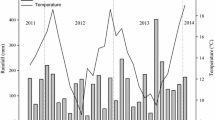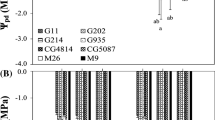Abstract
Eight apple genotypes were grown in a calcareous soil to evaluate relative Fe deficiency chlorosis susceptibility of apple rootstocks. Two soybean genotypes, known to be chlorosis-resistant and-susceptible in wet calcareous soils in Iowa and Minnesota, were used to calibrate the response of the apple genotypes. Two sites and two soil-water levels were used because high soil water is known to induce chlorisis in susceptible soybean and citrus cultivars.
Generally, apple seedlings were more sensitive to high pH and high HCO3 − induced chlorosis than the sensitive soybean cultivar. Fe levels were about 14 μg·g−1 dry wt in new leaves of apple seedlings grown on low (35%) or high (48%) soil moisture levels. Similar foliar Fe concentrations were produced on soils from either of two fields of Harps silty clay loam soil (Typic Calciaquoll). Although chlorosis developed in all apple species, we observed varying degrees of severity based on visual observations.Malus micromalus, M. domestica (cv., ‘York’ seedling) andM. domestica (cv., ‘Golden Delicious’ from tissue culture) all expressed a lower level of chlorosis compared with the other species tested (M. zumi, M. hupehensis, M. honanensis, andM. baccata). Additionally, those apples with lower visual chlorosis also contained slightly higher foliar Fe levels and lower leaf P levels. This same pattern held true between the susceptible and resistant soybean cultivars.
Similar content being viewed by others
References
Bindra A S 1976 Iron chlorosis in fruit-plants: the role of calcium carbonate in its incidence. J. Res. Punjab Agric. Univ. 8, 359–361.
Chaney R L 1985 Breeding soybeans to prevent mineral deficiencies or toxicities,In. World Soybean Research Conf. III Proc. Ed. R. Shibles. p. 453–459. Iowa.
Council on Soil Testing and Plant Analysis 1980 Handbook on reference methods for soil testing. 1111 plant Sci. Bldg., Univ. Georgia, Athens, Georgia.
Coulombe B A, Chaney R L and Wiebold W J 1984a Bicarbonate directly induced iron-chlorosis in susceptible soybean cultivars. Soil Sci. Soc. Am. J. 48, 1297–1301.
Coulombe b A, Chaney R L and Wiebold W J 1984b Use of bicarbonate in screening soybeans for resistance to iron chlorosis. J. Plant Nutr. 7, 411–425.
Chen Y and Barak P 1982 Iron nutrition of plants in calcareous soils. Adv. Agron. 35, 217–240.
Fleming A L, Chaney R L and Coulombe B A 1984 Bicarbonate inhibits Fe-stress response and Fe uptake-translocation of chlorosis—susceptible soybean cultivars. J. Plant Nutr. 7, 699–714.
Inskeep W P and Bloom P R 1986 Effects of soil moisture on soil pCO2, soil solution bicarbonate, an iron chlorosis in soybeans. Soil Sci. Soc. Am. J. 50, 946–952.
Jackson M 1970 Soil chemical Analysis. 6th ed. Prentice-Hall, Englewood Cliffs, N.J.
Leggett G E and Argyle D P 1983 The DTPA-extractable iron, manganese, copper, and zinc from neutral and calcareous soils dried under different conditions. Soil Sci. Soc. Am. J. 47, 518–522.
Levy Y 1984 The effect of sprinkler and drip irrigation on lime-induced chlorosis of citrus. Scietia Hort. 22, 249–255.
Mason H L, Fehr W R, Bahrenfus J B and Voss B K 1982 Iowa soybean yield test report. Iowa State Univ., Coop. Ext. Serv. AG-18-2.
Nakos G 1979 Lime-induced chlorosis inPinus radiata. Plant and Soil 52, 527–536.
Shear C B and Faust M 1980 Nutritional ranges in deciduous tree fruits and nuts. Hort. Reviews 2, 142–163.
Tong Yue Ao, Fan F, Korcak R F and Faust M 1986 Effect of micronutrient, phosphorus and chelate to Fe ratio on the growth. chlorosis and mineral content of York apple seedlings. J. Plant Nutr. 9, 23–41.
Venkatraju K and Marschner H 1981 Inhibition of iron-stress reactions in sunflower by bicarbonate. Z. Pflanzenernaehr Bodenkd. 144, 339–355.
Viets F G and Lindsay W L 1973 Testing soils for zinc, copper, manganese and iron. pp 153–172.In Son Testing and Plant Analysis. Eds L M Walsh and J D Beaton. Soil Sci. Soc. Am., Madison, WI.
Wallace A, Romney E M and Alexander G V 1976 Limeinduced chlorosis caused by excess irrigation water. Commun. in Soil Sci. Plant Analysis 7, 47–49.
Zhou Hou Ji, Korcak R F, Fan F and Faust M 1984 The effect of bicarbonate induced Fe chlorosis on mineral content and Ca45 uptake of apple seedlings. J. Plant Nutr. 7, 1355–1364.
Zhou Hou Ji, Korcak R F and Faust M 1985 Effect of Fe level and solution culture pH on severity of chlorosis and mineral content of apple seedlings. J. Plant Nutr. 8, 345–355.
Author information
Authors and Affiliations
Rights and permissions
About this article
Cite this article
Yue Ao, T., Chaney, R.L., Korcak, R.F. et al. Influence of soil moisture level on apple iron chlorosis development in a calcareous soil. Plant Soil 104, 85–92 (1987). https://doi.org/10.1007/BF02370629
Received:
Revised:
Issue Date:
DOI: https://doi.org/10.1007/BF02370629




